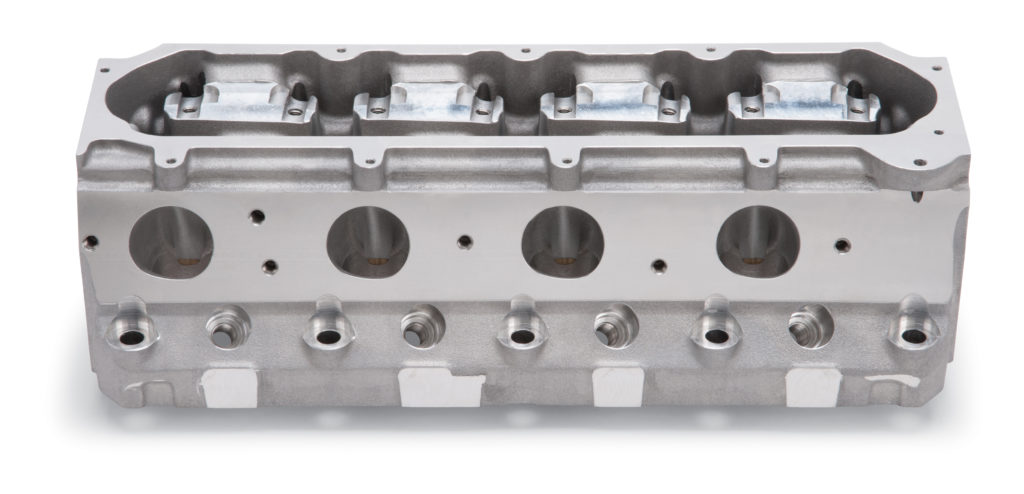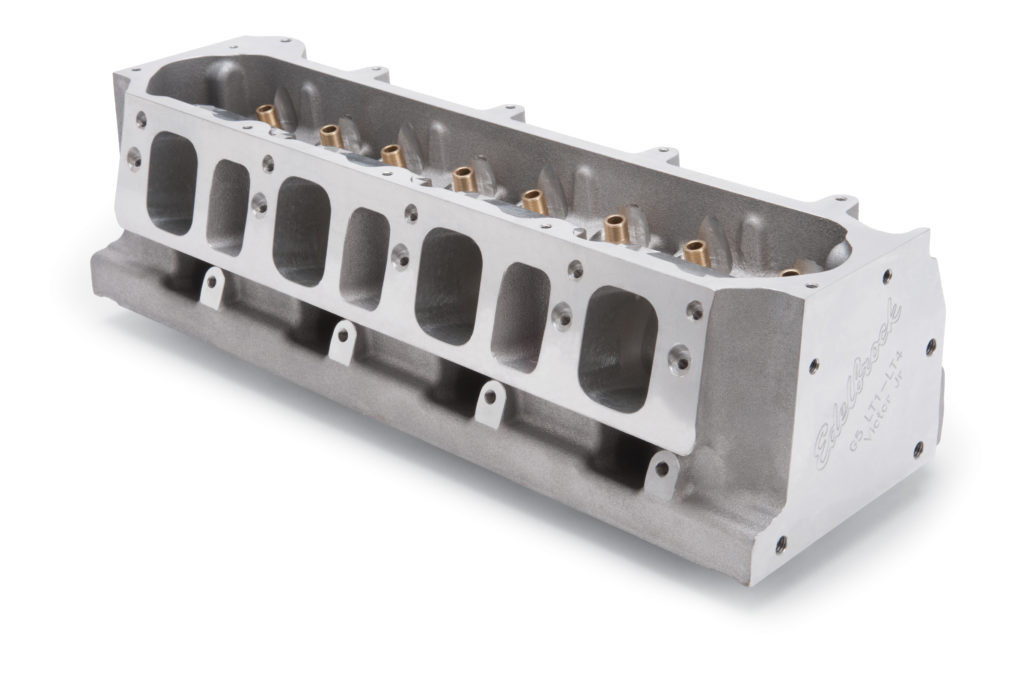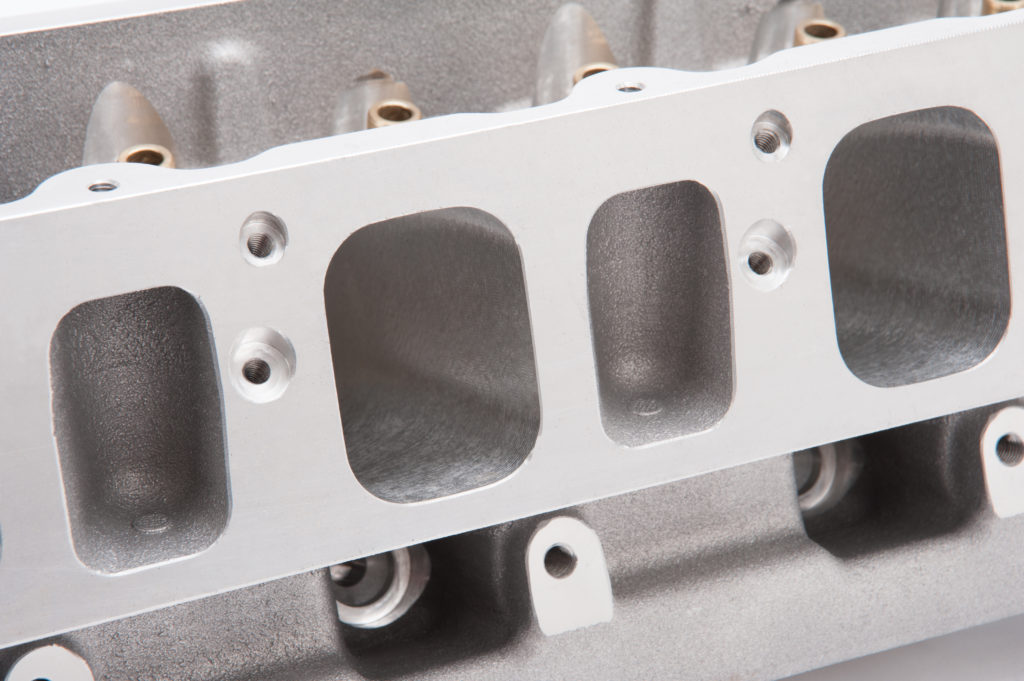Edelbrock Performance has been around for 80-plus years. From the legendary Ford Flathead V8 to today’s GM Gen. V offerings, automotive engineering and technology has evolved a lot over those 80 years.
And Edelbrock has continued to evolve with it.
Dr. Rick Roberts has led the design and engineering process on some of Edelbrock’s most game-changing products, including its new cylinder heads for the GM Gen. V LT1/LT4 platform. Edelbrock introduced the two new heads—the entry-level Performer RPM and more performance-oriented Victor Jr.—at the 2016 SEMA Show in Las Vegas. The Performer RPM retains the stock port locations, but the CNC-ported Victor Jr. heads incorporate some creative engineering, including redesigned and relocated exhaust ports.
We caught up to Dr. Roberts, and he explained how Edelbrock was able to re-engineer the latest GM cylinder head design to unlock even more power for high performance enthusiasts. This is the story of how Edebrock’s GM Gen. V cylinder heads came to be:
OnAllCylinders: What were your initial thoughts when the Gen. V LT platform came out?
Dr. Rick Roberts: I had just gone to the 2012 SEMA show and, in the General Motors booth, they had the new LT1 head inside a plexi-glass display. It was the first time I had ever seen it. Naturally I was really excited and interested to take a look at it. And I remember being struck by the way the ports wrapped around each other. I looked at it and I was like: “Wait a minute, they switched intake and exhaust from what the LS’s are.” The thing that struck me first, though, was that they canted the valves. I had wanted to do that on the LS for quite some time, but when I had suggested it, everyone looked at me like I was crazy! Once they saw the factory was doing it, it was like a seal of approval—like it was an OK thing to do.
OAC: Edelbrock was one of the very first to market with cylinder heads for the LT platform. What made you decide to move on the LT platform so quickly.
Dr. Roberts: Well, it took about a year. We said we better do this because nobody else has done it yet and being first is an advantage. As big as Edelbrock is we have not often been the first in a new market. The LS market was an example of that. We had a chance to correct that in the LT market. We decided : Let’s be the first to do this.
OAC: What did you learn from that LS experience?
Dr. Roberts: Prior to the LS, there were not really good heads coming from any of the factories so it was fairly easy to produce a replacement head that improved performance. I remember looking at the LS head with Vic and both of us shaking our heads saying what in the world are we going to do to improve this? Well eventually we did improve it but it took time. It also made us better at what we do. A lot better. So when this LT came along we knew that this is the future so we better get busy.
OAC: So where do you even start when looking at ways to improve a part like the factory cylinder head?
Dr. Roberts: When I saw the way the ports wrapped around each other, I thought how is that exhaust port right? It has GOT to run better if the exhaust port is straight. But then you look at it in more detail, and you see that by wrapping the exhaust port around the intake the way it does, it makes the wall between the intake and exhaust extremely thin. It compromises the intake port. So then I get the SAE paper, and they’re talking about swirl and turbulence and all of this kind of stuff. And I was like: “OK, I can see that, but apart from the exhaust initiating that swirling motion, I can’t see any other reason to have that exhaust exit where it is.” It’ll be interesting to see in the years to come—presuming (GM) makes this engine another three or four years—to see if that exhaust port exit doesn’t get changed over time.
OAC: What were your initial goals when you started out?
Dr. Roberts: I knew we could make a stock replacement head, but I knew we could also make it a little better than the stock one. How about letting me put a straight exhaust port in there and just see what happens? (This turned out to be the the Victor Jr. —Ed.). They said, “go ahead and see what you can do with it.” In paying attention to what I gleaned from the SAE paper, I knew I didn’t want to be cavalier about the whole thing. I knew that if I straightened the exhaust port out, I would not only get a better exhaust port, I’d probably get a better intake port—I’m just talking bulk flow here. Now, paying attention to what I read in the (SAE) report, I thought I’d need to keep the tip of the spark plug at exactly the same location that it is stock. And I think if I improve flow, I’ve got to improve swirl by the same percentage. If I improve flow 5%, then I’d better improve swirl by the same percentage; thus, keeping the same swirl ratio—the ratio of bulk flow to swirl—a constant. If I do that, the in-cylinder motion, which was so important, would remain pretty much the same. That was really the key to the whole program.
 OAC: Why is the swirl/flow percentage so important?
OAC: Why is the swirl/flow percentage so important?
Dr. Roberts: The one thing I garnered from the SAE paper, and from my own reading on direct injection, is the necessity for pay attention to the in-cylinder motion. When you don’t have fuel in the port and you’re injecting it all in the combustion process, the motion in the cylinder can be really important to getting the results you want. I can certainly recognize, looking at the GM paper, that they did take an outside-the-box approach to this thing, perhaps by necessity. So the whole thing with deciding to swap the intake and exhaust valves was very interesting to me (as far as how) it had an effect on the in-cylinder motion and so forth.
There are some things with some direct injection that can be problematic. Maybe what we’ll see as time goes on is some kind of combination of direct injection with port injection. That can help you with boost applications and so forth. I just think it’s going to evolve.
OAC: What kind of research and testing went into the project?
Dr. Roberts: Unlike the factory, we don’t have the personnel or resources to investigate to the level of depth they do. So we’re kind of forced to use a combination of the technology we do have—things like CFD, simulation, and combustion-related stuff. It’s not as if we’re completely blind; you just have to use those tools you have. But the simulation stuff, for example—it doesn’t make sense for us to have that in-house.
OAC: What other areas of the head design did you focus on?
Dr. Roberts: We put a bigger valve in –that always helps. Moving the exhaust port over made the intake port so you could put a little bigger window over top of the short turn than you could with the stock head. We got considerably better flow. The trick was getting the swirl where we needed it. And here’s this back-and forth thing with port regarding its shape to accomplish that. We just had a very simple swirl meter—a lot of people have them; I don’t have many people acturally use them. but it’s just a simple paddle wheel that spins around on the axis of the cylinder bore and you record the rpm as you’re flowing. And really—that’s the story right there. From that point on, it’s the normal process of fighting with the flowbench trying to get it to flow as well as possible.
OAC: How about on the valvetrain—what areas did you address there?
Dr. Roberts: I did not make it a requirement to exactly duplicate the stock valve angles and geometry. So, even though from five feet away everything may look stock, take a closer look. There are some differences—and they’re differences for a good reason. That did mean, though, I couldn’t use the factory drawings. I had go from scratch—an all-new valvetrain. I had to figure all the angles out, rocker arm geometry—all that kind of stuff. It still uses the stock rocker—we stuck with that. I would imagine over time you’ll see some aftermarket rockers, but what we wanted was a reasonably priced, extremely capable head for this new platform that people could take to the next level. We wanted something where, if the limits of the factory head had been met, this was your next step. I still don’t know if we’ve seen the best of what this head can do yet. We’ve done some of our own R&D here, and we really figure from what the standpoint of what the (Victor Jr.) heads flow, there shouldn’t be any problem on a supercharged engine making 1,000 horsepower and have it be reasonably streetable. You’d probably have to use race gas and added compression.
OAC: Any unexpected challenges along with way during the development?
Dr. Roberts: There were some other things with the head that were challenging. The first time we torqued the heads down, the head bolt bosses cracked. The bolt bosses are now bulletproof. We put gussets and everything in there to make sure we wouldn’t have any problems with them. Our cylinder head won’t necessarily be the most lightweight cylinder head, but it’s going to be plenty strong for whatever you’re going to do. That’s a compromise we’re going to make. I’d rather put more metal in it and make it a bit heavier than a stock head, knowing that it’s an edge against cracking or failing. If you’re looking to have the most lightweight head in the world on your Gen. V, then you should probably stick with a stock head. If you want to make more horsepower, go with the Edelbrock.
OAC: The Victor Jr. is CNC ported while the Performer RPM is more as-cast—what went into the decision to differentiate the heads in that way?
Dr. Roberts: I convinced them that the Victor Jr. head that it would be unique and would probably be a high performance product, so it’s almost expected it would be CNC ported. Rather than try to make as-cast ports for the Victor Jr. we went to a full CNC job to ensure we the results we want. That’s no way you can cast a port as accurately as you can machine it. However, on the stock replacement head, we decided we would only CNC the combustion chamber and kind of blend it into the port and then leave the port as-cast for price reasons. We thought that would make it more attractive price-wise.
OAC: What type of performance potential do you think the Victor Jr. heads have?
Dr. Roberts: We made 880 horsepower with race gas and I think not really the correct camshaft. It definitely is a head that begs for heavy duty use with a lot of other components. If you’re looking these heads and you’re going to put them on your otherwise stock engine, you’re probably not going to see that big of an improvement. Obviously, it’s for someone who is going to embrace the fact that the exhaust port is moved an inch and a half!
I’d say at this point, we’re proud of what we’ve accomplished. We’ve got a casting that we’ve beat on hard here, and we want to get back on the dyno. I’d like to see us make that 1,000 horsepower number here. It would be incredible to think there’s this 1,000 horsepower engine that sits there and idles quite civilly.




Comments